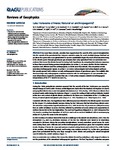Late Holocene climate: Natural or anthropogenic?
| dc.contributor.author | Ruddiman, WF | |
| dc.contributor.author | Fuller, DQ | |
| dc.contributor.author | Kutzbach, JE | |
| dc.contributor.author | Tzedakis, PC | |
| dc.contributor.author | Kaplan, JO | |
| dc.contributor.author | Ellis, EC | |
| dc.contributor.author | Vavrus, SJ | |
| dc.contributor.author | Roberts, C Neil | |
| dc.contributor.author | Fyfe, R | |
| dc.contributor.author | He, F | |
| dc.contributor.author | Lemmen, C | |
| dc.contributor.author | Woodbridge, Jessie | |
| dc.date.accessioned | 2017-01-05T16:00:36Z | |
| dc.date.available | 2017-01-05T16:00:36Z | |
| dc.date.issued | 2016-03 | |
| dc.identifier.issn | 8755-1209 | |
| dc.identifier.issn | 1944-9208 | |
| dc.identifier.uri | http://hdl.handle.net/10026.1/8204 | |
| dc.description.abstract |
<jats:title>Abstract</jats:title><jats:p>For more than a decade, scientists have argued about the warmth of the current interglaciation. Was the warmth of the preindustrial late Holocene natural in origin, the result of orbital changes that had not yet driven the system into a new glacial state? Or was it in considerable degree the result of humans intervening in the climate system through greenhouse gas emissions from early agriculture? Here we summarize new evidence that moves this debate forward by testing both hypotheses. By comparing late Holocene responses to those that occurred during previous interglaciations (in section 2), we assess whether the late Holocene responses look different (and thus anthropogenic) or similar (and thus natural). This comparison reveals anomalous (anthropogenic) signals. In section 3, we review paleoecological and archaeological syntheses that provide ground truth evidence on early anthropogenic releases of greenhouse gases. The available data document large early anthropogenic emissions consistent with the anthropogenic ice core anomalies, but more information is needed to constrain their size. A final section compares natural and anthropogenic interpretations of the δ<jats:sup>13</jats:sup>C trend in ice core CO<jats:sub>2</jats:sub>.</jats:p> | |
| dc.format.extent | 93-118 | |
| dc.language | en | |
| dc.language.iso | en | |
| dc.publisher | American Geophysical Union (AGU) | |
| dc.subject | anthropogenic | |
| dc.subject | climate | |
| dc.subject | Holocene | |
| dc.title | Late Holocene climate: Natural or anthropogenic? | |
| dc.type | journal-article | |
| dc.type | Review | |
| dc.type | Journal | |
| plymouth.author-url | https://www.webofscience.com/api/gateway?GWVersion=2&SrcApp=PARTNER_APP&SrcAuth=LinksAMR&KeyUT=WOS:000374690300003&DestLinkType=FullRecord&DestApp=ALL_WOS&UsrCustomerID=11bb513d99f797142bcfeffcc58ea008 | |
| plymouth.issue | 1 | |
| plymouth.volume | 54 | |
| plymouth.publication-status | Published | |
| plymouth.journal | Reviews of Geophysics | |
| dc.identifier.doi | 10.1002/2015rg000503 | |
| plymouth.organisational-group | /Plymouth | |
| plymouth.organisational-group | /Plymouth/Admin Group - REF | |
| plymouth.organisational-group | /Plymouth/Admin Group - REF/REF Admin Group - FoSE | |
| plymouth.organisational-group | /Plymouth/Faculty of Science and Engineering | |
| plymouth.organisational-group | /Plymouth/Faculty of Science and Engineering/School of Geography, Earth and Environmental Sciences | |
| plymouth.organisational-group | /Plymouth/REF 2021 Researchers by UoA | |
| plymouth.organisational-group | /Plymouth/REF 2021 Researchers by UoA/UoA14 Geography and Environmental Studies | |
| plymouth.organisational-group | /Plymouth/Research Groups | |
| plymouth.organisational-group | /Plymouth/Research Groups/Centre for Research in Environment and Society (CeRES) | |
| plymouth.organisational-group | /Plymouth/Research Groups/Centre for Research in Environment and Society (CeRES)/CeRES (Reporting) | |
| plymouth.organisational-group | /Plymouth/Research Groups/Marine Institute | |
| plymouth.organisational-group | /Plymouth/Users by role | |
| plymouth.organisational-group | /Plymouth/Users by role/Academics | |
| dc.rights.embargodate | 2016-09-01 | |
| dc.identifier.eissn | 1944-9208 | |
| dc.rights.embargoperiod | 6 months | |
| rioxxterms.versionofrecord | 10.1002/2015rg000503 | |
| rioxxterms.licenseref.uri | http://www.rioxx.net/licenses/under-embargo-all-rights-reserved | |
| rioxxterms.type | Journal Article/Review |


